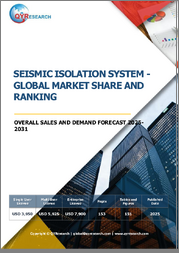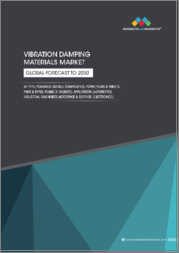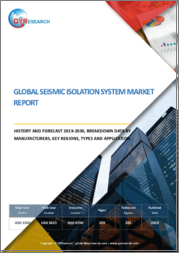
|
시장보고서
상품코드
1628109
내진 보강재 시장 : 시장 기회, 성장 촉진요인, 산업 동향 분석, 예측(2024-2032년)Seismic Reinforcement Material Market Opportunity, Growth Drivers, Industry Trend Analysis, and Forecast 2024 to 2032 |
||||||
세계의 내진 보강재 시장은 2023년 322억 달러로 평가되었고, 2024년부터 2032년까지 연평균 복합 성장률(CAGR) 5.5%로 확대될 것으로 예측되고 있습니다.
성장의 원동력이 되고 있는 것은 도시화의 진전과, 특히 지진이 발생하기 쉬운 지역에 있어서의 내진 인프라에 대한 요구의 고조입니다. 고층 빌딩이나 중요 인프라 등의 구조물에서는 지진시의 안전성을 확보하기 위해 고도의 내진 보강이 요구되고 있습니다. 세계의 건축 기준법의 강화에 의해 지진이 발생하기 쉬운 지역에서의 구조 내구성을 높이는 재료에 대한 수요가 더욱 높아지고 있습니다.
엄격한 규제 기준은 종종 최신 안전 요구 사항을 충족하기 위해 오래된 구조물을 개조해야 하며 새로운 개발에는 내진 재료를 사용해야 합니다. 지진이 자주 발생하는 지역에서의 강인한 인프라 구축에 대한 주목 증가는 내진 보강재의 중요한 필요성을 부각시키고 있습니다.
재료별로 보면 내진 보강재 시장은 탄소섬유, 스틸, 유리 섬유, 고무, 콘크리트 시멘트 등으로 분류됩니다. 2023년 매출은 132억 달러로 철강이 시장을 독점하고 2032년까지 약 6%의 연평균 복합 성장률(CAGR)로 성장할 것으로 예상됩니다. 탁월한 강도와 내구성으로 알려진 철강은 지진력을 견디는 건물 및 인프라 보강에 여전히 선호되고 있습니다. 비용 효과, 가용성 및 적응성에서 대규모 건설 및 리노베이션 프로젝트에 적합합니다.
| 시장 범위 | |
|---|---|
| 시작년 | 2023년 |
| 예측 연도 | 2024-2032년 |
| 시작 금액 | 322억 달러 |
| 예측 금액 | 520억 달러 |
| CAGR | 5.5% |
기능별로는 구조 강화, 면진, 충격 흡수 등으로 분류됩니다. 구조 강화 시장 점유율은 41%로, 2032년까지의 CAGR은 5.9%로 예측됩니다. 낡은 인프라가 수명을 맞이함에 따라 현행의 내진 기준을 충족시키기 위한 개수 요구가 급증하고 있습니다. 구조 강화의 노력은 기둥, 보, 기초 등의 내하중 부재를 보강하여 지진 응력에 견디는 능력을 향상시키는 데 중점을 두고 있습니다.
시장은 미국이 지배적인 지위를 차지하고 있으며 2023년 매출의 82%를 차지합니다. 지진 위험에 대한 인식과 재해에 강한 인프라 투자 증가가 시장 성장의 주요 요인이 되고 있습니다. 내진 안전성 향상과 공공 프로젝트에 자금을 제공하는 정부의 이니셔티브가 내진 보강재의 채용을 더욱 가속화하고 있습니다.
정리하면 건축 기준법의 엄격화와 함께 건설 및 인프라에서의 안전 대책 강화 수요가 높아지고 있는 것이 세계의 내진 보강재 시장 성장을 뒷받침하고 있습니다.
목차
제1장 조사 방법 및 조사 범위
제2장 주요 요약
제3장 업계 인사이트
- 생태계 분석
- 밸류체인에 영향을 주는 요인
- 이익률 분석
- 파괴
- 장래의 전망
- 제조업체
- 유통업체
- 공급자의 상황
- 이익률 분석
- 주요 뉴스 및 이니셔티브
- 규제 상황
- 영향요인
- 성장 촉진요인
- 급속한 도시화와 건설 러쉬
- 건축 기준법의 변화 및 규제 강화
- 업계의 잠재적 위험 및 과제
- 시장의 포화와 치열한 경쟁
- 지속가능성에 대한 우려
- 성장 촉진요인
- 성장 가능성 분석
- Porter's Five Forces 분석
- PESTEL 분석
제4장 경쟁 구도
- 서문
- 기업 점유율 분석
- 경쟁 포지셔닝 매트릭스
- 전략 전망 매트릭스
제5장 시장 추계 및 예측 : 재료별(2021-2032년)
- 주요 동향
- 스틸
- 탄소섬유
- 유리 섬유
- 콘크리트 시멘트
- 고무
- 기타(하이브리드 등)
제6장 시장 추계 및 예측 : 기능별(2021-2032년)
- 주요 동향
- 구조 강화
- 충격 흡수 및 댐퍼
- 면진
- 기타(균열 방지 등)
제7장 시장 추계 및 예측 : 용도별(2021-2032년)
- 주요 동향
- 빌딩 및 주택 건설
- 교량 및 육교
- 터널 및 지하 인프라
- 댐 및 물 인프라
- 기타(전력 인프라 등)
제8장 시장 추계 및 예측 : 최종 용도별(2021-2032년)
- 주요 동향
- 건설
- 운수
- 에너지 및 유틸리티
- 공공 인프라
- 기타(해양 등)
제9장 시장 추계 및 예측 : 유통 채널별(2021-2032년)
- 주요 동향
- 직접 유통
- 간접 유통
제10장 시장 추계 및 예측 : 지역별(2021-2032년)
- 주요 동향
- 북미
- 미국
- 캐나다
- 유럽
- 영국
- 독일
- 프랑스
- 이탈리아
- 스페인
- 러시아
- 아시아태평양
- 중국
- 인도
- 일본
- 한국
- 호주
- 라틴아메리카
- 브라질
- 멕시코
- 중동 및 아프리카
- 아랍에미리트(UAE)
- 사우디아라비아
- 남아프리카
제11장 기업 프로파일
- 3M
- Alemite
- Arcelor Mittal
- Arup Group
- BASF
- Freyssinet
- Hilti Group
- Hitech Materials
- Lintec & Toray
- Mammoet
- Schneider Electric
- Sika
- Tata Steel
- Tensar International
- US Concrete
The Global Seismic Reinforcement Material Market was valued at USD 32.2 billion in 2023 and is anticipated to expand at a CAGR of 5.5% from 2024 to 2032. The growth is driven by increasing urbanization and the rising need for resilient infrastructure, particularly in regions prone to earthquakes. Structures such as high-rise buildings and critical infrastructure demand advanced seismic reinforcement to ensure safety during seismic events. Strengthened building codes worldwide have further fueled the demand for materials that enhance structural durability in earthquake-prone areas.
Strict regulatory standards often require retrofitting older structures to meet modern safety requirements and mandate the use of earthquake-resistant materials in new developments. The growing focus on building resilient infrastructure in areas with frequent seismic activity highlights the critical need for seismic reinforcement materials.
By material, the seismic reinforcement material market is categorized into carbon fiber, steel, glass fiber, rubber, concrete and cement, and others. Steel dominated the market with revenue of USD 13.2 billion in 2023 and is expected to grow at a CAGR of around 6% through 2032. Known for its exceptional strength and durability, steel remains a preferred choice for reinforcing buildings and infrastructure to withstand seismic forces. Its cost-effectiveness, availability, and adaptability make it suitable for large-scale construction and retrofitting projects.
| Market Scope | |
|---|---|
| Start Year | 2023 |
| Forecast Year | 2024-2032 |
| Start Value | $32.2 Billion |
| Forecast Value | $52 Billion |
| CAGR | 5.5% |
Based on function, the market is divided into structural strengthening, seismic isolation, shock absorption, and others. Structural strengthening held a 41% market share and is projected to grow at a CAGR of 5.9% through 2032. As older infrastructure reaches the end of its lifespan, the need for retrofitting to meet current seismic standards has surged. Structural strengthening efforts are focused on reinforcing load-bearing components such as columns, beams, and foundations to improve their ability to endure seismic stresses.
The U.S. holds a dominant position in the market, accounting for 82% of revenue in 2023. Awareness of seismic risks and increasing investment in disaster-resilient infrastructure have been key contributors to market growth. Government initiatives to fund seismic safety upgrades and public projects have further accelerated the adoption of seismic reinforcement materials.
In summary, the rising demand for enhanced safety measures in construction and infrastructure, coupled with stricter building codes, is propelling the growth of the seismic reinforcement material market globally.
Table of Contents
Chapter 1 Methodology & Scope
- 1.1 Market scope & definitions
- 1.2 Base estimates & calculations
- 1.3 Forecast calculations
- 1.4 Data sources
- 1.4.1 Primary
- 1.4.2 Secondary
- 1.4.2.1 Paid sources
- 1.4.2.2 Public sources
Chapter 2 Executive Summary
- 2.1 Industry synopsis, 2021-2032
Chapter 3 Industry Insights
- 3.1 Industry ecosystem analysis
- 3.1.1 Factor affecting the value chain
- 3.1.2 Profit margin analysis
- 3.1.3 Disruptions
- 3.1.4 Future outlook
- 3.1.5 Manufacturers
- 3.1.6 Distributors
- 3.2 Supplier landscape
- 3.3 Profit margin analysis.
- 3.4 Key news & initiatives
- 3.5 Regulatory landscape
- 3.6 Impact forces
- 3.6.1 Growth drivers
- 3.6.1.1 Rapid urbanization and growing construction
- 3.6.1.2 Changing building codes and stricter regulations
- 3.6.2 Industry pitfalls & challenges
- 3.6.2.1 Market saturation and intense competition
- 3.6.2.2 Sustainability concerns
- 3.6.1 Growth drivers
- 3.7 Growth potential analysis
- 3.8 Porter's analysis
- 3.9 PESTEL analysis
Chapter 4 Competitive Landscape, 2023
- 4.1 Introduction
- 4.2 Company market share analysis
- 4.3 Competitive positioning matrix
- 4.4 Strategic outlook matrix
Chapter 5 Market Estimates & Forecast, By Material, 2021-2032 (USD Billion) (Million Units)
- 5.1 Key trends
- 5.2 Steel
- 5.3 Carbon fiber
- 5.4 Glass fiber
- 5.5 Concrete and cement
- 5.6 Rubber
- 5.7 Others (hybrid, etc.)
Chapter 6 Market Estimates & Forecast, By Function, 2021-2032 (USD Billion) (Million Units)
- 6.1 Key trends
- 6.2 Structural strengthening
- 6.3 Shock absorption & damping
- 6.4 Seismic isolation
- 6.5 Others (crack prevention, etc.)
Chapter 7 Market Estimates & Forecast, By Application, 2021-2032 (USD Billion) (Million Units)
- 7.1 Key trends
- 7.2 Building & residential construction
- 7.3 Bridges & overpasses
- 7.4 Tunnels & underground infrastructure
- 7.5 Dams & water infrastructure
- 7.6 Other (power infrastructure, etc.)
Chapter 8 Market Estimates & Forecast, By End Use, 2021-2032 (USD Billion) (Million Units)
- 8.1 Key trends
- 8.2 Construction
- 8.3 Transportation
- 8.4 Energy & utilities
- 8.5 Public infrastructure
- 8.6 Others (marine, etc.)
Chapter 9 Market Estimates & Forecast, By Distribution Channel, 2021-2032 (USD Billion) (Million Units)
- 9.1 Key trends
- 9.2 Direct
- 9.3 Indirect
Chapter 10 Market Estimates & Forecast, By Region, 2021-2032 (USD Billion) (Million Units)
- 10.1 Key trends
- 10.2 North America
- 10.2.1 U.S.
- 10.2.2 Canada
- 10.3 Europe
- 10.3.1 UK
- 10.3.2 Germany
- 10.3.3 France
- 10.3.4 Italy
- 10.3.5 Spain
- 10.3.6 Russia
- 10.4 Asia Pacific
- 10.4.1 China
- 10.4.2 India
- 10.4.3 Japan
- 10.4.4 South Korea
- 10.4.5 Australia
- 10.5 Latin America
- 10.5.1 Brazil
- 10.5.2 Mexico
- 10.6 MEA
- 10.6.1 UAE
- 10.6.2 Saudi Arabia
- 10.6.3 South Africa
Chapter 11 Company Profiles
- 11.1 3M
- 11.2 Alemite
- 11.3 Arcelor Mittal
- 11.4 Arup Group
- 11.5 BASF
- 11.6 Freyssinet
- 11.7 Hilti Group
- 11.8 Hitech Materials
- 11.9 Lintec & Toray
- 11.10 Mammoet
- 11.11 Schneider Electric
- 11.12 Sika
- 11.13 Tata Steel
- 11.14 Tensar International
- 11.15 U.S. Concrete



















